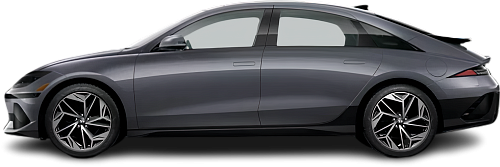Hyundai Ioniq 6 Standard Range RWD vs Tesla Model 3 Standard Range
Struggling to Decide? Let AI Help!
Your AI Summary Is Ready!
General Info
The Hyundai Ioniq 6 Standard Range RWD (2023-…) is currently produced, it has a starting price of $37500. The Tesla Model 3 Standard Range (2019-2020) has been discontinued. You can find it for as low as $12993 on the used car market.
The two vehicles share the same body style: Sedan.
| Property | Hyundai Ioniq 6 Standard Range RWD | Tesla Model 3 Standard Range |
|---|---|---|
| Years of Production | 2023-… | 2019-2020 |
| Current Status | Produced | Discontinued |
| Country of Manufacture | South Korea | China, Germany, USA |
| Body Style | Sedan | Sedan |
| Market Availability | EU, USA | EU, USA |
| Price USA (New) | $37500 | - Price USA (New) |
| Price USA (Used) | $25500 | $12993 |
| GCC Score | 6.3 | 6.1 |
Range and Efficiency
Even though the Tesla Model 3 Standard Range (2019-2020) has a larger battery, the Hyundai Ioniq 6 Standard Range RWD (2023-…) higher energy efficiency results in a longer real-world driving range.
| Property | Hyundai Ioniq 6 Standard Range RWD | Tesla Model 3 Standard Range |
|---|---|---|
| Range (EPA) | 240 mi | 220 mi |
| Range (WLTP) | 267 mi | - Range (WLTP) |
| Range (GCC) | 227 mi | 209 mi |
| Battery Capacity (Nominal) | 58 kWh | 60 kWh |
| Battery Capacity (Usable) | 54 kWh | 57.5 kWh |
| Efficiency per 100 mi | 23.8 kWh/100 mi | 27.5 kWh/100 mi |
| Efficiency per kWh | 4.2 mi/kWh | 3.63 mi/kWh |
| Range and Efficiency Score | 7.5 | 6.3 |
Charging
The Hyundai Ioniq 6 Standard Range RWD (2023-…) features an advanced 800-volt architecture, whereas the Tesla Model 3 Standard Range (2019-2020) relies on a standard 400-volt system.
The Hyundai Ioniq 6 Standard Range RWD (2023-…) offers faster charging speeds at DC stations, reaching up to 175 kW, while the Tesla Model 3 Standard Range (2019-2020) maxes out at 170 kW.
The Hyundai Ioniq 6 Standard Range RWD (2023-…) features a more powerful on-board charger, supporting a maximum AC charging power of 11 kW, whereas the Tesla Model 3 Standard Range (2019-2020) is limited to 7.7 kW.
| Property | Hyundai Ioniq 6 Standard Range RWD | Tesla Model 3 Standard Range |
|---|---|---|
| Max Charging Power (AC) | 11 kW | 7.7 kW |
| Max Charging Power (DC) | 175 kW | 170 kW |
| Architecture | 800 V | 400 V |
| Charge Port | CCS Type 1 | Tesla (NACS) |
| Charging Score | 7 | 5.7 |
Performance
Both vehicles are rear-wheel drive.
The Tesla Model 3 Standard Range (2019-2020) boasts greater motor power and accelerates faster from 0 to 60 mph.
| Property | Hyundai Ioniq 6 Standard Range RWD | Tesla Model 3 Standard Range |
|---|---|---|
| Drive Type | RWD | RWD |
| Motor Type | PMSM | PMSM |
| Motor Power (kW) | 111 kW | 208 kW |
| Motor Power (hp) | 149 hp | 279 hp |
| Motor Torque | 258 lb-ft | 310 lb-ft |
| 0-60 mph | 8.5 s | 5.8 s |
| Top Speed | 115 mph | 140 mph |
| Performance Score | 3.5 | 5 |
Dimensions
The Hyundai Ioniq 6 Standard Range RWD (2023-…) is longer and taller, but about the same width as the Tesla Model 3 Standard Range (2019-2020).
The Hyundai Ioniq 6 Standard Range RWD (2023-…) boasts a more extended wheelbase.
| Property | Hyundai Ioniq 6 Standard Range RWD | Tesla Model 3 Standard Range |
|---|---|---|
| Length | 191.1 in | 184.8 in |
| Width (with Mirrors) | 81.6 in | 82.2 in |
| Width (w/o Mirrors) | 74 in | 72.8 in |
| Height | 58.9 in | 56.9 in |
| Wheelbase | 116.1 in | 113.2 in |
Cargo and Towing
Both models feature a convenient frunk (front trunk), providing additional storage space.
Neither vehicle is officially rated for towing in the US.
| Property | Hyundai Ioniq 6 Standard Range RWD | Tesla Model 3 Standard Range |
|---|---|---|
| Number of Seats | 5 | 5 |
| Curb Weight | 3395 lb | 3552 lb |
| Cargo Volume (Trunk) | 14.2 ft3 | 19.8 ft3 |
| Cargo Volume (Max) | - Cargo Volume (Max) | 43.6 ft3 |
| Cargo Volume (Frunk) | 1.6 ft3 | 3.1 ft3 |
| Towing Capacity | - Towing Capacity | - Towing Capacity |
| Cargo and Towing Score | 5.5 | 5.1 |




